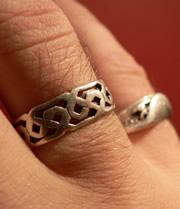 How an allergy to metal develops is a matter of much speculation.Addstyle
How an allergy to metal develops is a matter of much speculation.AddstyleAllergic reactions to metal are on the rise, although no one knows why. Now research suggests that bacterial infections experienced while wearing metal objects may be responsible.
Metal allergies are often merely a nuisance, leading to rashes where jewellery is worn. But reactions can become severe in dental patients wearing braces, and potentially life-threatening in surgery patients who develop a sensitivity to implants. Nickel causes the most trouble because it is widely used, but allergies to chromium, silver and even gold are not unknown. And they seem to be on the rise: one study in Singapore1 saw nickel allergies go from 14% of the population in 1984 to 20% in 2003.
How an allergy to metal develops is a matter of much speculation. A part of the immune system known as T cells are thought to be involved, says Roger Katz, an allergist at the University of California School of Medicine, Los Angeles. "But how T cells are involved and what they are doing is a mystery," he says.
Yasuo Endo at Tohoku University in Sendai, Japan, and his colleagues had noticed that in previous animal experiments looking at metal allergies, researchers often used a chemical trigger or 'adjuvant' to encourage an allergy to form. In mice, researchers used hydrogen peroxide to stimulate the animals' immune system and encourage a reaction.
Endo and his team suspected that something was similarly provoking allergic reactions to form in humans — but not hydrogen peroxide, as we rarely come into contact with it. Instead, they focused their attention on a set of molecules called lipopolysaccharides, commonly found in bacteria, which are known to be able to provoke other immune responses.
Mystery reaction
The team injected small groups of mice with a nickel salt solution, with some groups also receiving a dose of lipopolysaccharides. Ten days later, the mice were injected with the same nickel salt in the ear, and the team measured the resulting inflammation.
Mice that didn't get the lipopolysaccharide dose in the first injection had almost no reaction to the nickel within a day of the second exposure; but mice that did receive lipopolysaccharides had an almost immediate, strong reaction to the metal, they report in Clinical and Experimental Allergy2.
Lipopolysaccharides are found naturally at low levels in the human body, but the concentrations found in the cell walls of many pathogenic bacteria species are much higher. So is it possible that people who suffer from specific bacterial infections are more likely to develop metal allergies? Endo certainly thinks so. "If people come in contact with a metal during infection, I speculate that this could lead them to develop metal allergies later in life," he says.
But Katz is cautious. "This is definitely an adjuvant for metal sensitivity that we had not considered before, but we need to look closely at the exact type of immune reaction that is being induced before we can be certain that lipopolysaccharides are the cause of metal allergies," he says.
ADVERTISEMENT
In the meantime, metal allergies remain mysterious. It isn't even clear whether people become allergic to metals themselves, or to proteins incorporating the metals.
Endo's team also found that mice sensitized with nickel and lipopolysaccharides later reacted to a number of other metals including cobalt, chromium, palladium, copper and silver. This implies that a complex made of lipopolysaccharides and nickel may be the thing that triggers the immune system, which then becomes sensitive to any kind of lipopolysaccharide-metal complex. If so, then wearing a nickel bracelet during an infection may predispose you to a silver allergy later in life.
Visit our maytriggermetala.html">newsblog to read and post comments about this story.
